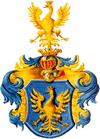Iłownica, Silesian Voivodeship
Iłownica [iwɔvˈnit͡sa] (German: Illownitz) is a village in Gmina Jasienica, Bielsko County, Silesian Voivodeship, southern Poland.[1] It has a population of 1,018 (2016).
Iłownica | |
|---|---|
Village | |
Church of Saint John Paul II in Iłownica | |
 Coat of arms | |
 Iłownica | |
| Coordinates: 49°52′13.44″N 18°51′25.45″E | |
| Country | Poland |
| Voivodeship | Silesian |
| County | Bielsko |
| Gmina | Jasienica |
| First mentioned | 1305 |
| Government | |
| • Mayor | Czesław Szkorupa |
| Area | |
| • Total | 7.775 km2 (3.002 sq mi) |
| Population (2016) | |
| • Total | 1,018 |
| • Density | 130/km2 (340/sq mi) |
| Time zone | UTC+1 (CET) |
| • Summer (DST) | UTC+2 (CEST) |
| Postal code | 43-394 |
| Car plates | SBI |
It lies on the Iłownica River, right tributary of the Vistula, in the Upper Vistula Valley of Oświęcim Basin, in the historical region of Cieszyn Silesia. The name of both the river and the village is derived from loam (Polish: ił, adjective: iłowy).[2]
History
The village was first mentioned in a Latin document of Diocese of Wrocław called Liber fundationis episcopatus Vratislaviensis from around 1305 as item in Gylownita.[3][4][5] It meant that the village was in the process of location (the size of land to pay a tithe from was not yet precised). The creation of the village was a part of a larger settlement campaign taking place in the late 13th century on the territory of what will be later known as Upper Silesia.
Politically the village belonged initially to the Duchy of Teschen, formed in 1290 in the process of feudal fragmentation of Poland and was ruled by a local branch of Piast dynasty. In 1327 the duchy became a fee of the Kingdom of Bohemia, which after 1526 became part of the Habsburg Monarchy.
The village with Kisielów was bought from Karl Freyherrn von Celesta by Teschener Kammer in 1792 for 120,000 florins.[6]
After Revolutions of 1848 in the Austrian Empire a modern municipal division was introduced in the re-established Austrian Silesia. The village as a municipality was subscribed to the political district of Bielitz (Bielsko) and the legal district of Schwarzwasser (Strumień). According to the censuses conducted in 1880, 1890, 1900 and 1910 the population of the municipality grew from 707 in 1880 to 744 in 1910 with a majority being native Polish-speakers (99.1%-99.9%) accompanied by a few German-speaking people (at most 7 or 0.9% in 1910), in terms of religion in 1910 majority were Roman Catholics (97%), followed by Protestants (22 or 3%).[7] The village was also traditionally inhabited by Cieszyn Vlachs, speaking Cieszyn Silesian dialect.
After World War I, fall of Austria-Hungary, Polish–Czechoslovak War and the division of Cieszyn Silesia in 1920, it became a part of Poland. It was then annexed by Nazi Germany at the beginning of World War II. After the war it was restored to Poland.
In the years 2005-2011 a John Paul II church was built in the village, a filial church of Rudzica.
Footnotes
- "Central Statistical Office (GUS) - TERYT (National Register of Territorial Land Apportionment Journal)" (in Polish). 2008-06-01.
- Mrózek, Robert (1984). Nazwy miejscowe dawnego Śląska Cieszyńskiego [Local names of former Cieszyn Silesia] (in Polish). Katowice: Uniwersytet Śląski w Katowicach. p. 79. ISSN 0208-6336.
- Panic, Idzi (2010). Śląsk Cieszyński w średniowieczu (do 1528) [Cieszyn Silesia in the Middle Ages (until 1528)] (in Polish). Cieszyn: Starostwo Powiatowe w Cieszynie. p. 297-299. ISBN 978-83-926929-3-5.
- Schulte, Wilhelm (1889). Codex Diplomaticus Silesiae T.14 Liber Fundationis Episcopatus Vratislaviensis (in German). Breslau.
- "Liber fundationis episcopatus Vratislaviensis" (in Latin). Retrieved 13 July 2014.
- Kaufmann, Aloys (2007 (re-edition)). Gedenkbuch der Stadt Teschen (in German). 2. Cieszyn. p. 311. ISBN 978-83-914331-8-8. Check date values in:
|year=(help) - Piątkowski, Kazimierz (1918). Stosunki narodowościowe w Księstwie Cieszyńskiem (in Polish). Cieszyn: Macierz Szkolna Księstwa Cieszyńskiego. p. 261, 280.
References
- Polak, Jerzy (2011). Obrazki z dziejów gminy Jasienica. Cieszyn: Muzeum Śląska Cieszyńskiego. ISBN 978-83-922005-6-7.
External links
- (in Polish) Information on the Gmina Jasienica website
| Wikimedia Commons has media related to Iłownica, Silesian Voivodeship. |

